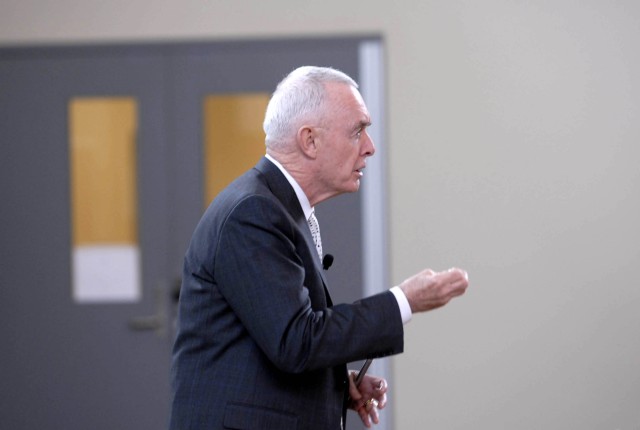FORT LEWIS, Wash. - One of the nation's most-recognized and accomplished retired U.S. Army generals brimmed with confidence last week at the prospect of I Corps headquarters soon falling in on the Multi-National Corps-Iraq mission.
Barry McCaffrey was the second retired four-star general in three weeks to address leaders of America's Corps and Fort Lewis prior to their deployments to Southwest and Central Asia. Former Army chief of staff, Gordon Sullivan, spoke to Fort Lewis leaders Feb. 4.
While on post, McCaffrey granted an exclusive interview to the Northwest Guardian, in which he discussed the missions and cap-abilities of I Corps headquarters and subordinate units after a professional development session.
"I'm absolutely confident in I Corps' ability to do the mission," said the former commander-in-chief of U.S. Army Southern Command. "And it's a good time to change (the MNC-I headquarters), because it's going to be a different war. This will be the wind-down to a $700 billion, 36,000-casualty operation. It's not clear to me how you do that, but these guys are going to go in there and figure it out."
Though McCaffrey now manages his own consulting firm in Virginia, he stays close to the Army as an adjunct professor of international relations at the U.S. Military Academy at West Point. He also appears regularly as a military commentator on NBC television.
"I've been an observer of the Army for a long time, and we've never had a more effective fighting force, (demonstrating) courage, technical competence, initiative and discipline," he said. "(It is an) unbelievable institution. And it starts at the top. This guy, Chuck Jacoby. I've watched him since he was a captain. He's got no ego. He's smart as a whip, tremendous humility, enormous battle experience. That's who we've got running the Army, thank God."
McCaffrey arrived at Fort Lewis the morning the Department of the Army announced that 5th Brigade, 2nd Infantry Division would become the first Stryker brigade to deploy to Afghanistan in support of Operation Enduring Freedom this summer. He has visited Afghanistan several times.
"I am thrilled they're sending Stryker(s) to Afghanistan," he said. "I've been pounding away at Gen. (John) Abizaid (former CINC of U.S. Central Command) and every commander in Afghanistan that we had a tiny footprint in there - we had way too few Soldiers."
Thanks to organizations like the 864th Engineer Battalion building roads, bridges and other construction projects in Afghanistan, the infrastructure is better prepared to accommodate Strykers and other armored vehicles.
"We've finally got the Ring Road (linking the cities of Kabul, Kandahar and Herat) three-fourths done," McCaffrey said. "We're starting a $10-billion program to build roads to the provincial capital and the district capitals. We've got to be able to move around that country at high speeds and on occasion, there are going to be 100 to 400 Taliban on the ground when we get there. We needed armor. Stryker can move on those emergent road networks."
The general said light U.S. forces have survived so far in OEF thanks in large part to aviation assets.
"Thank God for Army aviation, U.S. Air Force and Naval air, because we would have lost a half-dozen platoon-sized units killed to the last man if it weren't for Apache helicopters, AC-130s and F-16s."
The Stryker brigade will not be the sole answer in Central Asia, McCaffrey said. There are large areas of Afghanistan in which they will be less effective.
"Obviously it's not going to work up in Hindu Kush (the mountainous area in eastern and northern Afghanistan crossing into Pakistan)," McCaffrey said. "It's not going to work in a whole bunch of places. But my guess is ... 75 percent of the crucial things we've got to fight over, Strykers can get there within six hours' overnight march and be there with overwhelming firepower and then put enormous numbers of dismounted infantry on a battle. The more we use Strykers, we're going to find our use of air power goes down because you won't be a platoon-sized unit trying to deal with an unknown number of Taliban with heavy machine guns and mortars. So I'm thrilled. It's the right thing to do."
He praised Stryker organizations' versatility, as maneuver units, quick reaction forces and even morale builders, invoking his early career Vietnam experience.
"(They represent) a safety net, an insurance policy," McCaffrey said. "And by the way, what if there's suddenly a Tet '68 in Kabul' Do you want to go into town with light-infantry forces or arm 100 majors with M-4s' Or do you want to bring in at high speed in the dark a Stryker infantry battalion'"
McCaffrey insisted the U.S. mission in Afghanistan is not counterinsurgency operations.
"We're there to (support) the Afghan Security Forces," he said.
Don Kramer is a reporter with Fort Lewis' Northwest Guardian.


Social Sharing